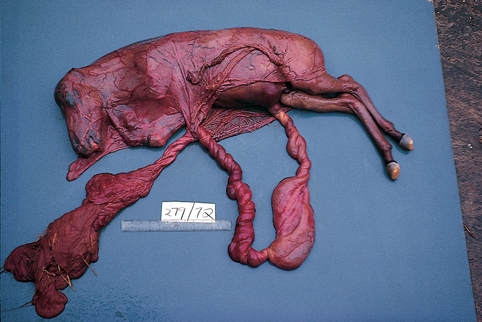Difference between revisions of "Equine Reproduction and Stud Medicine Q&A 05"
Jump to navigation
Jump to search
| Line 19: | Line 19: | ||
*The fetal abdomen is distended (with an excess of peritoneal fluid). | *The fetal abdomen is distended (with an excess of peritoneal fluid). | ||
*Fetal tissues are autolysed. | *Fetal tissues are autolysed. | ||
| − | |l1= | + | |l1=Umbilical Cord Torsion |
|q2= Which of these is likely to have contributed directly to foetal death, and what is the likely pathogenesis? | |q2= Which of these is likely to have contributed directly to foetal death, and what is the likely pathogenesis? | ||
|a2= | |a2= | ||
| Line 25: | Line 25: | ||
*The dilated abdomen is a secondary feature resulting from serosal effusion (not to be confused with the same change in EHV-l abortions). | *The dilated abdomen is a secondary feature resulting from serosal effusion (not to be confused with the same change in EHV-l abortions). | ||
*At the time of abortion, histologically the outer villus epithelium often appears relatively well preserved, probably as a result of direct diffusion of nutrients and oxygen across the fetomaternal junction. This may in part account for why placental dehiscence and expulsion of the fetus in this type of abortion occurs some time after fetal , the fetus characteristically being very autolysed when aborted. | *At the time of abortion, histologically the outer villus epithelium often appears relatively well preserved, probably as a result of direct diffusion of nutrients and oxygen across the fetomaternal junction. This may in part account for why placental dehiscence and expulsion of the fetus in this type of abortion occurs some time after fetal , the fetus characteristically being very autolysed when aborted. | ||
| − | |l2= | + | |l2=Umbilical Cord Torsion |
|q3= How important are these changes as a cause of abortion? | |q3= How important are these changes as a cause of abortion? | ||
|a3= Fetal death associated with excessive cord length (over 80 cm total length and 41 cm amniotic length), twisting and vascular compromise is currently the commonest single cause of observed non-infectious abortion. | |a3= Fetal death associated with excessive cord length (over 80 cm total length and 41 cm amniotic length), twisting and vascular compromise is currently the commonest single cause of observed non-infectious abortion. | ||
| − | |l3= | + | |l3=Umbilical Cord Torsion |
|q4= What used to be the commonest cause of abortion in thoroughbreds? | |q4= What used to be the commonest cause of abortion in thoroughbreds? | ||
|a4= Before ultrasound scanners became routinely used in pregnancy diagnosis, twinning was the commonest cause of abortion in Thoroughbreds. | |a4= Before ultrasound scanners became routinely used in pregnancy diagnosis, twinning was the commonest cause of abortion in Thoroughbreds. | ||
Latest revision as of 14:19, 5 September 2011
| This question was provided by Manson Publishing as part of the OVAL Project. See more Equine Reproduction and Stud Medicine questions |
A thoroughbred mare aborted an 8-month old autolysed foetus as shown above:
| Question | Answer | Article | |
| What abnormalities are evident on external examination? |
|
Link to Article | |
| Which of these is likely to have contributed directly to foetal death, and what is the likely pathogenesis? |
|
Link to Article | |
| How important are these changes as a cause of abortion? | Fetal death associated with excessive cord length (over 80 cm total length and 41 cm amniotic length), twisting and vascular compromise is currently the commonest single cause of observed non-infectious abortion.
|
Link to Article | |
| What used to be the commonest cause of abortion in thoroughbreds? | Before ultrasound scanners became routinely used in pregnancy diagnosis, twinning was the commonest cause of abortion in Thoroughbreds.
|
Link to Article | |
